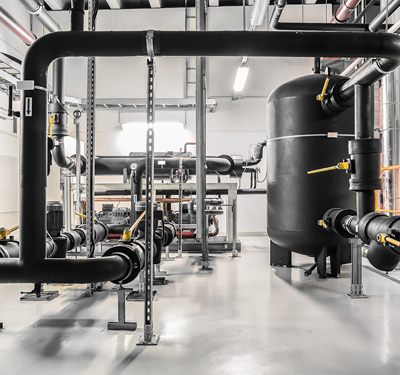

Closed Loop Water Treatment
Posted by Bob Schneider on in Engineering
In a central plant system, there are two types of water piping loops: closed and open. An open loop is from the chiller to the cooling tower. As the water flows through the tower, it is open to the atmosphere. Because of evaporation at the cooling tower, city water is introduced to replace the evaporated water.
A closed loop system would be from the chiller to the air handling units. This loop does not require continuous city water makeup, since all the circulated water returns to the chiller.
Why should you check the water condition in the closed loop? After all, there should not be any contaminants entering the water, as in a cooling tower open loop. There is little or no makeup water.
The answer is that closed loop systems are susceptible to corrosion and low pH. The presence of dissolved gases such as oxygen or carbon dioxide, microbiological growth, or deposits of particulate matter is of concern and should be treated.
How do they get into the system?
When the system was initially filled, more than likely it was with city water. As the water was cooled or heated, oxygen was released. If a new air handling unit is connected into the system, it will introduce new water and air. If any part of the piping was changed or modified, the fresh water will introduce and release oxygen.
Mill scale and other materials like weld slag that are not completely flushed out during initial construction can be carried though the piping and end up in your coils, pumps or chillers.
A biofilm microbiological growth can develop or grow from untreated water.
All of these problems may cause or contribute to one or more of the others. Microbiological growth causes corrosion and contributes to fouling. Corrosion causes fouling and provides an ideal environment for the growth of micro organisms.
Corrosion may lead to costly equipment repair or replacement and may cause piping leaks. Fouling of coils and heat exchangers may decrease their heat transfer efficiencies.
Because the closed loop system does not require blow down or bleed off like a cooling tower, with the daily chemical treatment and attention, the closed loop often tends to be forgotten. A welldesigned and implemented plan should be part of your maintenance program.
Depending on your system condition and water analysis, a chemical cleaning maybe required. This will rid the system of any fouling materials, microbiological growth and mill scale.
Once the loop is cleaned, a corrosion inhibitor will be selected by your water treatment company. This inhibitor needs to be selected carefully to be sure it won’t harm any of your system’s components—copper and steel pipes, bronze pump impellers, rubber vibration isolators, and flange gaskets and “O” rings in valves. The makeup water also should be analyzed.
A possible microbiocide maybe added if your system is susceptible to microbiological growth.
A testing and monitoring program should be established to insure that your system stays clean and free from corrosion and growths.
A relatively small amount of preventative maintenance will help in reducing costly repairs and replacements of equipment and piping. And it will help maintain the efficiency of your system.

 Previous STORY
Previous STORY